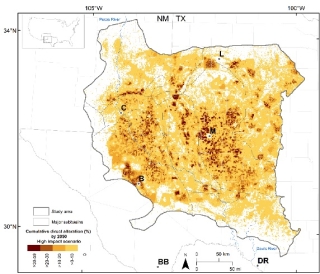Projected Landscape Impacts from Oil and Gas Development Scenarios in the Permian Basin, USA

Jon Paul Pierre, John R. Andrews, Michael H. Young, Alexander Y. Sun, Brad D. Wolaver
Environmental Management, 2020, https://doi.org/10.1007/s00267-020-01308-2
Study Summary
Projecting landscape impacts from energy development is essential to land management decisions. We forecast potential landscape alteration resulting from oil and gas well-pad construction, through 2050, across the economically important Permian Basin of Texas and New Mexico, USA. This was accomplished by extending trends observed in well-pad construction and energy production from 2008 to 2017 into the future. We considered three cases that differed based on either drilling activity or conservation approaches. We found that, for low-, medium-, and high-impact scenarios, ~60,000, ~180,000, and ~430,000 new well pads could be constructed, potentially leading to ~1000, ~2800, and
~6700 km2 of new direct landscape alteration. Almost two-thirds of all new well pads will be constructed within the geologic boundaries of the Delaware and Midland Basins. We found that indirect effects (from edges) could increase by twofold, and that the ratio between indirect and direct alteration could decline by half as alteration intensifies and overlaps with existing alteration. The degree of direct alteration in the Chihuahuan Desert, within which most activities occur, could increase by 70, 200, and 500%, depending on the impact scenarios. These scenarios can be used to design proactive conservation strategies to reduce landscape impacts from future oil and gas development.
Why is this research important and why do the results matter?
- Land managers can use our forecasts to design proactive conservation plans that minimize potential landscape impacts and maintain healthy landscapes.
- The results in this paper include only the well-pad construction itself, not the pipelines and roadways that are critical aspects of infrastructure.
- All energy sources can and will impact landscapes, whether oil and gas or renewable energy. All energy infrastructure should be considered when assessing whole landscape impacts.